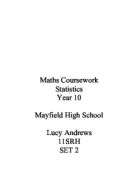My Hypothesis
I will now use raw data from my school (the Swaminarayan School). Then I will make a hypothesis, which I will then try to prove. My hypothesis is too seeing whether there is correlation between the maths scores and the CAT scores.
I have decided that I will be using a sample size of 30 as less than 30 would not represent the population. More than 30 would make it rather difficult to plot the data on the scatter graph. I will be doing a stratified random sample so that when I standardise the data it will correspond with the proportion of data sets.
When a student is scheduled to join our school he/she will take an IQ (CAT) test. So, I will not have to arrange for an IQ test to take place.
There are five different tables.
Table 1 consists of 11 students.
Table 2 consists of 9 students.
Table 3 consists of 22 students.
Table 4 consists of 18 students.
Table 5 consists of 23 students.
This leads to a total of 83.
I will now determine how many students I have to use from each table.
This is determined by:-
Num of Students in Table * by Num of data I’m using = Num of data I
Total Number of Students has to use.
Table 1=11/83*30=3.97 rounded up to 4.
So this means I will use 4 students from table 1.
Table 2=9/83*30=3.25 rounded down to 3.
So this means I will use 3 students from table 2.
Table 3=22/83*30=7.95 rounded up to 8.
So this means I will use 8 students from table 3.
Table 4=18/83*30=6.5 rounded up to 7.
So this means I will use 7 students from table 4.
Table 5=23/83*30=8.31 rounded down to 8.
So this means I will use 8 students from table 5.
I will now have to determine a way of randomising the results to keep it fair. There are two methods of which I can do this. The first method is to use the randomising button on the scientific calculator. Or my other option is to pick it out of a hat. I have selected the randomising button on my calculator as it is the easier, faster and more efficient way of selecting random numbers.
Randomly Selected Students.
From Table 1:
- 2
- 8
- 6
- 11
From Table 2:
- 4
- 5
- 9
From Table 3:
- 6
- 10
- 2
- 20
- 8
- 22
- 17
- 5
From table 4:
- 16
- 5
- 6
- 10
- 4
- 14
- 9
From Table 5:
- 6
- 21
- 14
- 7
- 17
- 12
- 11
- 4
Proving My Hypothesis.
Because everything has been decided I shall now make a scatter graph to prove my hypothesis. I will distinguish whether there is a correlation and then use the Spearman’s Rho Theorem to learn the strength of the correlation.
As seen above there is positive correlation between the Maths results and the CAT results.
I will know learn the strength of the two positive by using the Spearman’s Rho Theorem.
Spearman’s Rho Theorem
I will be explaining the method in steps to ensure clarity.
Step One.
In order to do this I have included a table underneath. A key is included.
Step 2
My Sample Size will now have to be stated. I will refer to it as N.
Step 3
I will now have to count the number of paired scores. In this case the number of paired scores is 30. So N=30.
Step 4
I will now multiply N by it’s own value, twice, then subtract it’s own value.
(30*30*30)-30 =27000-30=26970.
Step 5
I shall now total all the values in the column D2.
49+110.25+1+20.25+12.25+0.25+4+42.25+6.25+6.25+64+1+100+30.25+272.25+49+1+1+625+1+0+2.25+36+81+16+81+225+20.25=
1872.25
Step 6
I will now multiply the value I obtained in step 5 by 6; then divide the result by the value I found in step 4.
1872.25*6 = 11233.5 =0.4165 to four d.p
26970 26970
Step 7
I shall now find Rho by subtracting the number I obtained in step 6 from 1.
1-0.4165=0.5835
Step 8
My Rho number has exceeded all of the numbers below:
0.306
0.364
0.432
0.478
My Conclusion
I am going to end my coursework by expressing how I would improve on my hypothesis should the opportunity to repeat it arise. I may use a bigger population or maybe use different methods to randomize numbers. I am glad that my hypothesis didn’t turn out to be a null one. From this investigation I have learnt a lot about statistics and would jump at the opportunity to learn more about the topic.







